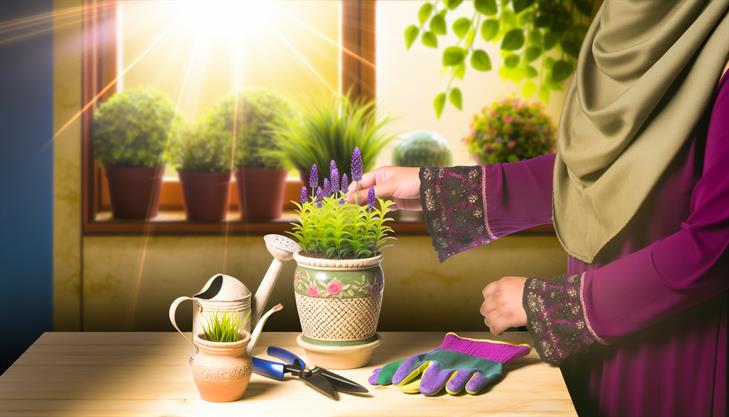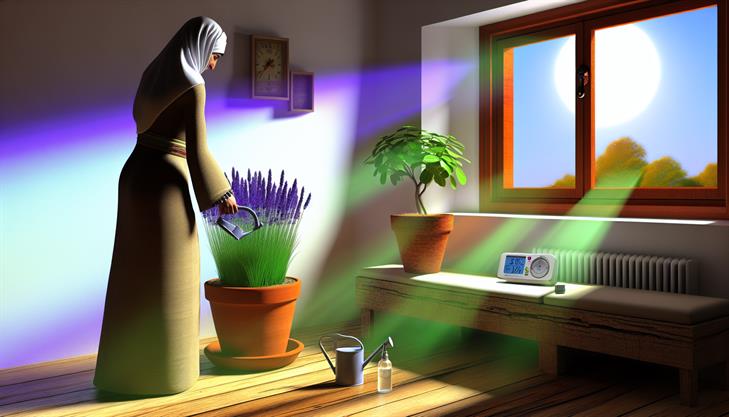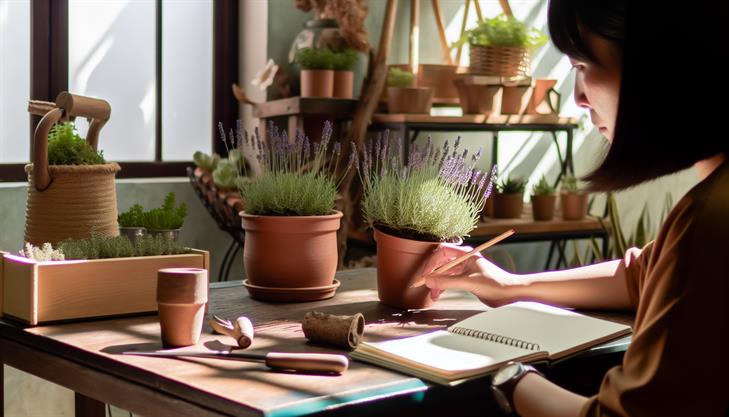Imagine stepping into a serene sanctuary filled with the gentle, soothing aroma of a lavender field—right in the comfort of your own home. Whether you’re an established green thumb or a budding indoor gardener, the allure of growing lavender indoors is as captivating as it is challenging. But can these perennially popular plants truly thrive away from the sunny meadows they are accustomed to? The short answer is yes, they can. Understanding the nuances of growing lavender indoors can transform your living space into a fragrant haven and offer a delightful touch of nature’s elegance to urban living. In this guide, we’ll explore the secrets to successfully nurturing lavender indoors, from choosing the right varieties to creating an optimal environment. Reading on will not only increase your gardening prowess but also enhance your home’s ambiance with the unmatched benefits of this aromatic herb. Prepare to embark on a journey that balances beauty and practicality, bringing a piece of the outdoors in.
Choosing the Right Lavender Variety for Indoors
Yes, lavender plants can indeed be grown indoors, offering a delightful way to bring the relaxing scent and tranquil beauty of lavender right into your home. However, growing lavender indoors requires attention to specific conditions to thrive. Here’s a comprehensive guide to help you succeed in growing lavender plants indoors.
Selecting the Right Variety
When considering which lavender variety to grow indoors, opt for smaller types that are better suited for container growth. Popular choices include:
- English Lavender (Lavandula angustifolia): Known for its fragrance and compact growth, it’s a great option for indoor cultivation.
- French Lavender (Lavandula dentata): It has a slightly different scent and striking foliage, providing a unique aesthetic.
- Spanish Lavender (Lavandula stoechas): With its distinctive flower shape, it adds an exotic touch to your indoor garden.
Optimal Growing Conditions
Light Requirements
Lavender thrives on sunlight. Aim to provide your lavender plant with 6 to 8 hours of direct sunlight daily:
- Placement: Place the lavender near a south-facing window where it will get ample sunlight.
- Supplemental Lighting: If natural light is insufficient, use grow lights to make up for any deficit. Position the lights about a few inches away from the plant to simulate natural sunlight.
Potting Tips
Choosing the right container and soil is crucial:
- Container: Use a pot with ample drainage holes to prevent water retention, which lavender does not tolerate well.
- Size: Consider a pot that’s at least 12 inches in diameter for proper root space.
- Soil: Opt for well-draining, sandy potting mix. You can enhance drainage by adding perlite or small gravel to the soil mixture.
Watering and Humidity
- Frequency: Water sparingly. Allow the top inch of soil to dry out between watering sessions to avoid root rot.
- Humidity: Lavender prefers dry conditions. Avoid placing it in overly humid areas such as bathrooms or kitchens.
- Air Circulation: Ensure good air flow around the plant to prevent fungal issues. A small fan can help if your indoor air is stagnant.
Common Issues and Troubleshooting
- Yellowing Leaves: This could indicate overwatering. Ensure the soil drains well and reduce watering frequency.
- Drooping or Wilting Plants: Often caused by too much water or insufficient light. Adjust accordingly.
- Lack of Flowers: If your lavender isn’t blooming, it might need more light. Increase its exposure to direct sunlight or extend the hours of artificial light.
Additional Tips for Indoor Lavender Care
- Pruning: Regular pruning helps maintain shape and encourages new growth. Trim back any leggy stems in early spring.
- Feeding: Lavender doesn’t require much fertilizer. A sparse application of a balanced, slow-release fertilizer in early spring can promote growth.
- Overwintering: Lavender can be sensitive to cold drafts. If your home gets chilly, ensure that the plant is kept away from windows that might bring in a draft.
Growing lavender plants indoors can be a rewarding endeavor, providing a fragrant, herbal haven right at home. Follow these guidelines, and enjoy the beauty and benefits lavender brings to your indoor space.
Optimal Care Tips for Indoor Lavender Plants
Lavender plants, renowned for their soothing aroma and striking purple blooms, are a favored addition to many gardens. However, many plant enthusiasts wonder, "Can lavender plants be grown indoors?" The answer is yes, with the right conditions and care, lavender can thrive indoors, allowing you to enjoy their beauty and fragrance throughout the year. Here’s a detailed guide on how to cultivate indoor lavender successfully.
Choosing the Right Variety
The first step to growing lavender indoors is selecting the appropriate variety. Some types are better suited for indoor cultivation due to their manageable size. English Lavender (Lavandula angustifolia) and French Lavender (Lavandula dentata) are two excellent choices, known for their resilience and aromatic foliage.
Planting in the Right Pot and Soil
Ensure you choose a pot with ample drainage holes. Lavender does not like excessive moisture, which can cause root rot. Opt for a clay or terracotta pot, which allows moisture to evaporate and prevents water retention.
Use a well-draining soil mix, ideally one designed for cacti or succulents. You can also mix standard potting soil with sand or perlite to enhance drainage.
Providing Adequate Light
Light is crucial for the growth of indoor lavender. Place your plant in a south-facing window where it can receive at least 6-8 hours of sunlight daily. If natural light is insufficient, consider supplementing with a grow light to provide the necessary light intensity.
Regulating Temperature and Humidity
Lavender prefers a temperate, dry environment. Maintain indoor temperatures between 65-75°F (18-24°C) during the day and slightly cooler at night. Avoid placing the plant near drafts, radiators, or air conditioners which can cause fluctuations in temperature.
Humidity should be moderate. If your indoor climate is particularly humid, use a fan to improve air circulation around the plant, which mimics the gentle breezes of its native Mediterranean habitat.
Watering Correctly
One common issue faced by indoor lavender growers is overwatering. Allow the soil to dry out slightly between waterings to prevent root rot. A good rule of thumb is to water when the top inch of soil feels dry. Ensure excess water can drain away, as stagnant moisture can harm the plant.
Pruning and Fertilizing
Regular pruning helps maintain a healthy lavender plant indoors. Trim back blooms once they have faded and prune any leggy growth to encourage bushier growth.
Fertilize sparingly with a balanced, slow-release fertilizer in the spring. Too much fertilizer can hinder blooming and result in excessive foliage growth.
Common Challenges and Solutions
- Leggy Growth: Often due to insufficient light. Ensure the plant receives adequate sunlight or supplemental lighting.
- Yellowing Leaves: A sign of overwatering. Check the drainage and reduce the frequency of watering.
- Pests: Lavender is generally resistant, but it can occasionally attract spider mites or aphids. A gentle spray with water or insecticidal soap can help manage these pests.
Additional Tips
- Rotate the plant occasionally to ensure even growth and exposure to sunlight on all sides.
- During winter, lavender’s growth may slow down. Adjust watering and light conditions accordingly.
- Harvest lavender buds just as their color peaks for the strongest fragrance. These can be dried and used for various aromatic purposes.
By following these comprehensive care instructions, you can successfully grow lavender plants indoors, bringing a touch of nature and a pleasant aroma to your home. With the right setup and care, the answer to "can lavender plants be grown indoors" becomes a resounding "yes," allowing you to enjoy the benefits of this lovely plant all year round.
Essential Tools for Indoor Lavender Gardening
Yes, lavender plants can be grown indoors successfully, and with the right care and setup, you can enjoy their fragrant blooms and foliage year-round inside your home. Here’s a detailed guide on how to grow lavender indoors, including essential tips and common issues to avoid.
Choosing the Right Lavender Variety
Start by selecting a variety that is well-suited for indoor growing. French lavender (Lavandula dentata) and Spanish lavender (Lavandula stoechas) are excellent choices due to their compact size and adaptability to indoor environments.
Step-by-Step Guide to Growing Lavender Indoors
-
Select the Right Pot:
- Choose a container with drainage holes to prevent waterlogged soil. A pot that is about 12-16 inches in diameter is ideal.
- Use a well-draining potting mix, such as a cactus mix or standard potting soil blended with sand or perlite to enhance drainage.
-
Find the Perfect Location:
- Lavender requires a lot of sunlight. Place your plant in a south-facing window where it can receive at least 6-8 hours of direct sunlight each day.
- If natural sunlight is insufficient, consider using a grow light to supplement the light.
-
Watering Routine:
- Water your indoor lavender plant sparingly. Allow the top inch of the soil to dry out between waterings.
- Overwatering is a common issue that can lead to root rot, so ensure you don’t keep the soil consistently wet.
-
Temperature and Humidity:
- Lavender thrives in temperatures between 50°F to 65°F at night and 60°F to 80°F during the day.
- Keep humidity low; lavender prefers dry air. Avoid placing the plant in a bathroom or kitchen where humidity levels might be higher.
-
Fertilizing Needs:
- Feed your lavender sparingly. A balanced, water-soluble fertilizer applied in early spring and mid-summer will suffice.
- Over-fertilizing can lead to excessive foliage growth at the expense of flowers.
Common Issues and Solutions
- Leggy Growth: If your lavender becomes leggy, it may not be receiving enough light. Consider repositioning it to a brighter spot.
- Yellow Leaves: This could indicate overwatering. Let the soil dry out completely before the next watering.
- No Blooms: Ensure adequate sunlight and don’t over-fertilize, as too much nitrogen can inhibit blooming.
Additional Tips for Indoor Lavender Success
- Rotate the pot weekly to ensure all sides receive equal light and encourage even growth.
- Prune after flowering to promote bushier growth and remove any spent flower spikes.
- If you notice slow growth or less vigorous plants, consider repotting every 1-2 years in fresh soil to provide new nutrients.
By following these setup tips and addressing potential issues promptly, lavender can thrive indoors. Its aromatic scent and lovely appearance can transform your home while offering a touch of nature indoors. Enjoy the calming qualities of your indoor lavender garden and the satisfaction of nurturing these beautiful plants.
Troubleshooting Common Indoor Lavender Issues
Growing lavender plants indoors can be a rewarding endeavor for those who appreciate the fragrant blooms and silvery foliage of this aromatic herb. However, cultivating lavender indoors can present unique challenges compared to outdoor planting. Here’s a comprehensive guide to help you successfully grow lavender indoors, addressing common issues and offering practical tips for optimal indoor care.
Selecting the Right Lavender Variety
Before diving into indoor gardening with lavender, it’s crucial to select the right variety. Some of the best lavender types for indoor growth include English Lavender (Lavandula angustifolia), French Lavender (Lavandula dentata), and Canary Island Lavender (Lavandula canariensis). These varieties tend to be more compact and better suited for confined environments.
Setting up the Indoor Environment
-
Light Requirements: Lavender plants thrive with plenty of sunlight. Aim to place your lavender in a south-facing window where it can receive at least 6-8 hours of direct sunlight each day. If natural light is limited, consider supplementing with a grow light to ensure the plant gets enough energy for healthy growth.
-
Temperature and Humidity: Lavender prefers slightly cooler temperatures, ideally between 60-70°F (15-21°C) during the day, with nighttime temperatures cooler yet consistent. It’s important to maintain low humidity levels, as high humidity can promote diseases. A room with good airflow can help keep humidity at bay.
-
Soil and Pot Selection: Use well-draining potting soil mixed with sand or perlite to enhance drainage, as lavender does not tolerate waterlogging. Choose a pot with adequate drainage holes to prevent root rot, a common issue when growing lavender indoors.
Watering and Feeding Indoor Lavender
-
Watering: Lavender plants need watering only when the soil is dry to the touch, approximately once every two weeks, depending on indoor conditions. Overwatering is a usual cause of failure, so allowing the soil to dry out between waterings is crucial.
-
Feeding: Indoor lavender doesn’t require much in the way of fertilization. A slow-release fertilizer administered once in the spring should suffice, or use a liquid fertilizer every 6-8 weeks during the growing season.
Troubleshooting Common Indoor Lavender Issues
-
Poor Flowering: If your lavender isn’t blooming, it might not be getting enough sunlight. Reassess its placement and consider using a full-spectrum light to boost flowering.
-
Yellow Leaves: This is often a sign of overwatering or poor drainage. Check the moisture level of the soil and adjust watering habits accordingly.
-
Fungal Issues: Indicators of fungal problems include wilting or browning stems. To combat this, improve air circulation, reduce humidity, and ensure the plant isn’t sitting in water.
Additional Tips for Success
-
Pruning: Regularly prune your indoor lavender to maintain shape and promote bushier growth. Pruning after the first flush of flowers can also encourage a second bloom.
-
Companion Plants: Be cautious when placing lavender with other indoor plants. It prefers its space due to its need for consistent airflow and dry conditions.
By selecting the right variety and providing optimal care, including proper light, temperature, and watering practices, lavender can indeed be successfully grown indoors. Addressing common issues promptly will ensure your lavender remains healthy and thrives in your indoor garden, adding beauty and fragrance to your home.
Creative Ways to Display and Enjoy Indoor Lavender.
Growing lavender plants indoors can be a delightful way to fill your home with their calming scent and elegant appearance. Not only do they enhance your indoor environment, but they are also relatively easy to manage with the right care. Here’s a comprehensive guide on how to successfully grow lavender plants indoors.
Choosing the Right Lavender Variety
To start, select a lavender variety that is well-suited for indoor growth. English lavender (Lavandula angustifolia) and French lavender (Lavandula stoechas) are popular choices, as they are compact and adapt well to indoor environments.
Setting Up Your Indoor Lavender Plant
-
Pot Selection: Choose a pot with good drainage. Lavender doesn’t thrive in waterlogged soil, so a pot with drainage holes is essential. A terra-cotta pot is ideal, as it helps absorb excess moisture.
-
Soil Requirements: Use a well-draining potting mix, such as a cactus mix or a mix of equal parts compost, sand, and perlite. This setup will mimic the plant’s natural habitat and prevent root rot.
-
Location: Place the lavender in a spot that receives plenty of sunlight. Lavender thrives with 6 to 8 hours of direct sunlight daily, so a south-facing window is perfect. If natural sunlight is inadequate, consider supplementing with a grow light.
Caring for Your Indoor Lavender
-
Watering: Lavender prefers dry conditions, so water only when the top inch of soil feels dry. Overwatering is a common issue that can lead to root rot.
-
Humidity and Air Circulation: Lavender thrives in low humidity environments. Ensure good air circulation around the plant by not crowding it with other plants. Using a small fan occasionally can help maintain air flow.
-
Temperature: Keep your indoor lavender in a room where the temperature remains between 60°F (15°C) and 70°F (21°C). Avoid placing it near drafts or heating vents.
-
Fertilization: Lavender doesn’t require much fertilizer. A light application of a balanced, water-soluble fertilizer every six weeks during the growing season (spring and summer) is ample.
Common Issues and Solutions
-
Leggy Growth: Insufficient light can cause lavender to become leggy and weak. Ensure your plant receives adequate sunlight or add a grow light if necessary.
-
Yellowing Leaves: This may indicate overwatering. Allow the soil to dry out between waterings and ensure proper drainage.
-
Powdery Mildew: This fungal infection can occur if air circulation is poor. Improve air flow and remove any affected leaves promptly.
Additional Tips
-
Regularly prune your lavender to encourage bushiness and more flower production.
-
Consider repotting annually to refresh the soil and encourage healthy root growth.
By following these steps, you can successfully grow lavender plants indoors, allowing you to enjoy their beauty year-round. Remember, patience and attention to your plant’s specific needs are keys to thriving, fragrant indoor lavender.
In conclusion, growing lavender plants indoors is entirely feasible with the right conditions and care. As we’ve explored, choosing the correct variety, ensuring ample sunlight or supplementing with grow lights, and maintaining proper soil moisture are critical steps to successful indoor lavender cultivation. By keeping your plants in a well-ventilated space and avoiding overwatering, you’ll promote healthy growth and prevent common issues such as root rot. Remember, patience is key, as lavender thrives over time with careful, consistent care.
As you embark on your indoor lavender-growing journey, experiment with different container sizes and placements to discover what works best in your space. And, as a final tip, consider regularly misting your lavender with a gentle solution of water and essential oils to enhance its natural fragrance and deter pests. Happy gardening!


